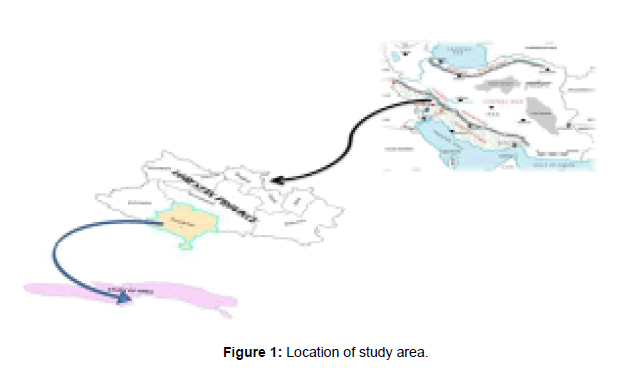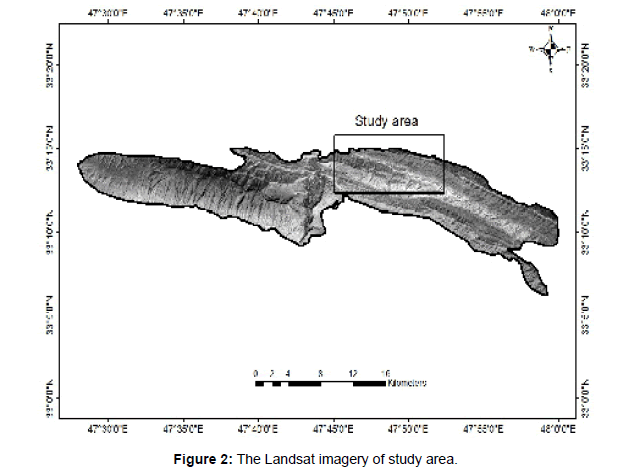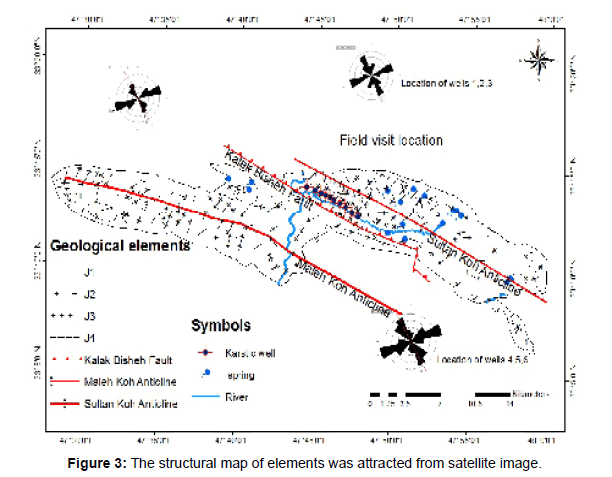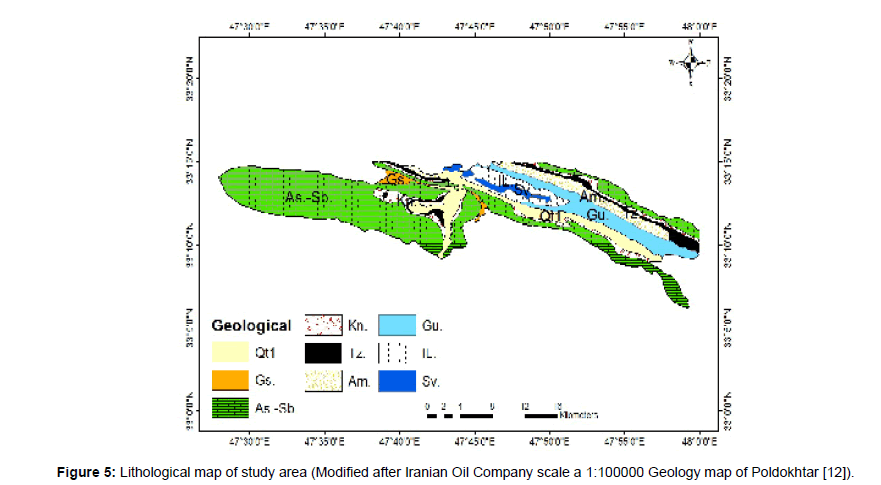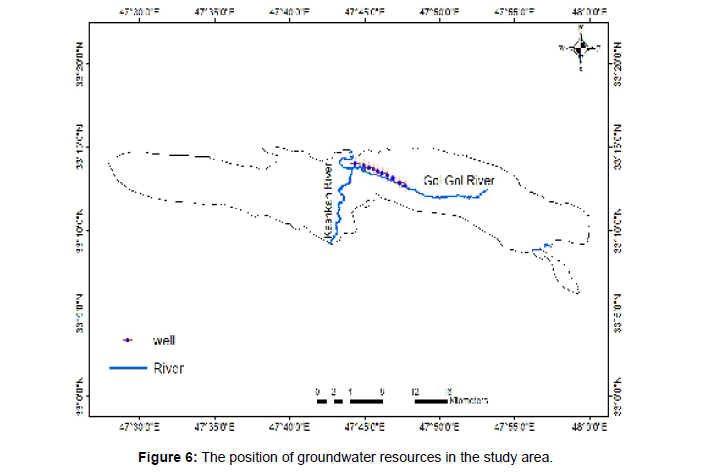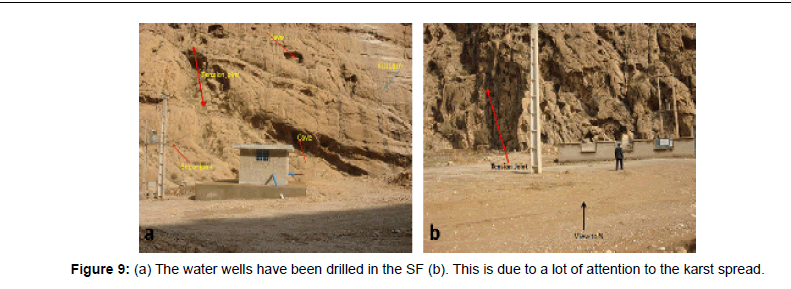Effects of Geological Factors on the Karstic Water Resources - A Case Study: The Sultan Anticline of South West Iran
Received: 31-Jan-2019 / Accepted Date: 22-Feb-2019 / Published Date: 28-Feb-2019
Abstract
The Sultan anticline (SA) is one of the most important sources of karstic water in the north of Poldokhtar city, southwest Iran. The Sarvak Formation (SF) limestone is inner main part of the SA. Age of the SF is upper Cretaceous. In this area 6 karstic wells are drilled with average depth of 130 meters (m). The wells are pumped more than 230 L/S of water. The location of the wells is in the Gol Gol valley that is a faulting valley. In this research, the effect of geological structures on the formation of water resources including wells and springs has been investigated. The results showed that geological structures, such as the Kalak Bisheh revers fault and tension joints, have an Impressive impact on the development of karst landforms. In the study area of the Kalak Bisheh fault has been removed, the outer cover of the SF includes Gurpi and Ilam Formations. The studies show that where the SF is uncovered on the joint’s location, especially tensile joints are formed caves and parallel galleries with the fold axis. The results show that the permanent and seasonal springs are respectively fault and contact type and are located in slope less than 5% and more than 12%. Also, in the study area, with increasing distance from the fault, the karst water resources are seen only in the form of permanent springs with a discharge of about 12 L/S in the Amiran and Gurpi Formations. At a distance of less than 1000 m from the fault, due to the removed of the SF cover are high the intensity of karstification and the development of water resources. It can be said that in the same areas, the most suitable place for the construction of new wells water is at the junction of perpendicular joints with the anticline of axis.
Keywords: Sultan Anticline; Poldokhtar city; Geological structures;Water resource; Iran
Introduction
Iran with an area of 1648195 km2 is situated in the Middle East and the middle part of Alp-Himalaya belt. Iran is mostly arid and semiarid, receiving an average of about 240 mm of annual precipitation. Approximately, 11% of the total area is covered by carbonate rocks [1]. Safe access to water resources is one of the main challenges in many countries, and the problem of water resources is particularly vital in arid and semi-arid regions that are severely hit by periodic droughts. Water shortage in such areas forces people to think of other resources, and since groundwater resources are limited, the karstic water is receiving more and more attention [2]. Groundwater flow is mainly driven by gravity in this system. Thus flow occurs more or less parallel to the slope within the weathered or blocked layers in mountain catchments [3]. Springs emerge when groundwater accumulates along the boundaries between permeable and less permeable units [3]. In order to identify the karstic water resources, the karst surface land-forms and geological structures such as faults and fracture systems need to be studied. The present study deals with some of the features of physical hydrogeology of karst including geologic structures affecting the circulation of water and permeability in carbonate aquifers. The development of karst, commonly known as karstification, is the result of the solution and leaching of rocks such as limestone, dolomite, gypsum, salt, and other soluble rocks [4]. The studies show that karst aquifers may fall into three groups according to their yield and that karst features may be divided into two groups in terms of their surficial and deep components and the direction of water movement in carbonate rocks is not necessarily parallel to the dip or the direction of the dip [4]. The effects of structural elements on the abundance of karst water resources have been studied in the Dehdasht area in Kohgilooyeh and Boerahmad Province in Iran. Results of this study show that there is a good relationship between the frequency of springs and the geological elements [5]. The effects of the tectonic stress, strain, and other factors such as geology, geomorphology, hydrodynamic, and erosion on the karstification phenomenon were studied in north of the Bern in lake Bern in Switzerland. The results show that there is a direct relationship between the karst and the tectonics [6]. The results of effects of karst and geological structures on the groundwater flow in the Yargon-Tanininm aquifer show that at the lowland area, the geological structure does not play a major role in the direction of groundwater flow [7]. The results of studies the effects of hydrogeology of lowland karst in Ireland show that hydrogeological conditions are not uniform in the lowland limestone [8]. Hydrogeology and water resources on the Isle of Wight were studied [9]. results show that groundwater from all these aquifers have been exploited to almost its full potential. Therefore, other solutions will be required to ensure future sustainable use of water on the island. Also, the structural-tectonic and geomorphology parameters of the karst corridors in Alpian limestone ridges (the Southern Carpathians, Romania) studied. Results show that structural features like joints, faults, and the homoclinal bedding are the major control factors in the size, orientation, and distribution of the karst corridors [10]. Moreover, the study of hydrogeological properties of fault zones in a karstic carbonate aquifer (Northern Calcareous Alps, Austria) show that the geological structures, and particularly faults, play an important role in Austria [11]. The main objective of this research is to find a relationship between Geological Structures and the Karst Water Resources in the Sultan anticline in South West of Iran.
Research Methodology
Location
The area under study is located in Northern Poldokhtar City (Figure 1). The mean annual precipitation in this region is from about 250 mm in lowland to 350 mm in upland areas. The Sultan Anticline does not have any land cover such as forest or vegetation, and therefore, there are a lot of rain flows on the surface. Surface drainage is mainly through two rivers, the Kashkan which flows southward and the Gol Gol which flows westward; although there are several other smaller streams.
Data collection
The data used in this study include a 1:25000 scale topographical map; the lithological map of units based a 1:100000 scale geological map, and a 1:20000 scale aerial photo, and Landsat ETM+ imagery (Figure 2).
The importance of karst water resources in study area
Before exploring the sources of karst water in the study area, the people of Poldokhtar city and 9 surrounding villages used the refined water of the Kashkan River. The Kashkan River water was not wellquality even after purification. After exploration the karstic sources that were located only at a distance less than 15 Km from north of Poldokhtar city, clean water has been supplied to more than 35,000 people. Volume pumping water from the Karstic wells in region is 230 L/S and more than 71 mm3/year.
Structural map of area
Depending on the prevailing orientation and the slope direction, the main fractures in this area consist of two distinct groups. The first group has a NW-SE direction. The axis of Sultan Anticline falls into the first group, and it has a slope between 85 to 90 degrees. The second group has a NE- SW direction with a 90- degree slope, which is upright to the axis of the Sultan Anticline. The regional groundwater resources, consisting of wells and springs, are around the fractures of the second group. For this reason, one can say that there is significant correlation between the abundance and orientation of fractures in the second group, and that there is a significant relationship between the slope gradient and the existence of a spring. The measurement of fractures, joints, slope directions, and dip angles, which was conducted at 5 stations, shows that general joints in the SW flank of the Sultan Anticline can affect the groundwater resources and the discharge duration. The major sets of joints on the Sultan Anticline can be divided into two groups: tension joints and shear joints (Table 1). Here, the tension joints play an important role in the karstification and development of karst water resource (Figure 3).
| Set Joint | Strike | Dip | Dip Direction | Spacing (m) | Opening (cm) | Filling | Continuity (m) | Description |
|---|---|---|---|---|---|---|---|---|
| J1 | 240 | 90 | 1.1 | 6 | Non | >30 | Tension | |
| J2 | 330 | 90 | 1.5 | 7 | Silt-Clay | >20 | Tension | |
| J3 | 215 | 38 | 125 | 0.8 | 6 | Silt-Clay | >2 | Shear |
| J4 | 130 | 42 | 220 | 1.2 | 5 | Silt-Clay | >2 | Shear |
Table 1: The characteristics of the main set joints in the Sultan Anticline in study area.
Based on the map of fractures and groundwater resources, one can find a meaningful relationship between the geological structures and wells or springs. In this area, there are 10 wells with discharge and depth about of 40 Lit/S and 173 m from ground surface. These wells are located in the SW of the Sultan Anticline. The absence of wells in other parts of this Anticline might be explained by the lack of developed karstification. Field studies show that wherever the Ilam Formation (which has a lithological argillaceous limestone) has been removed due to erosion, the karstification process has developed very well. The karst landform such as caves, Karrens, and channels can be seen in this part. Moreover, there is a good relationship between the type of joints and the induced karstic water wells or springs, in a way that joints with a NESW direction have a greater role in the development of karstification (Figure 4).
Stratigraphy
The area under study is situated in the southwest of the folded Zagros in the north of Kabir Kuh Mountain. According to the geological map (Figure 5) the Sultan Anticline consists of the Sarvak, Ilam and Gurpi Formations. The SF is formed by the body of the Sultan Anticline that is covered by the Ilam Formation, but the Ilam Formation has been removed in some areas due to erosion. The SF consists of the massive carbonate rock, which is the oldest Formation in central Sultan Anticline. The Ilam Formation consists of well- bedded argillaceous limestones. In this area, the boundary of the Ilam Formation is an unconformity with the SF. The Gurpi Formation consists mainly of low-weathering, soft, bluish-grey marl and shale with subordinate argillaceous limestone bands. The important geological structures in the region are the Sultan and the Malleh Koh Anticlines, with a NW-SE direction, which is the general direction of the folded Zagros. This area has been surveyed by the National Iranian Oil Company on a 1:100000 scales and the geological map scheduled for publication in 1985.
Hydrogeology
The Karst aquifers may be placed in three groups according to water- bearing capacity as follows:
(1) Aquifers of low yield to wells,
(2) Aquifers in which the yield of water to springs and wells ranges from low to intermediate, and
(3) Aquifers in which the yield of water to springs and wells ranges from intermediate to very high [4].
In this region, the water aquifer can be placed in group 3. In aquifers of this type, the permeability may increase with depth. The water exists under artesian and non- artesian conditions. For example, the Gol Gol spring is an artesian spring, but water wells in this area have unconfined aquifers. Movement of the water in some parts of the aquifer occurs through channels, tubular openings, and through the zone of aeration at the upper water table. In this location below the water table, where there is recharge through caves and other openings, water may become turbid in the zone of saturation after rains; where there are channels and holes above the water table. The water table will upraise, and the discharge of springs will increase, and the recharge water versatile below from the surface may move a significant distance horizontally through channels before reaching the zone of saturation. Generally speaking, the main aquifer in the SW flank of the Sultan Anticline has both channel flow and vertical flows. In this region, in order to identify and map the water resources, has been used on a 1/25000 scale topographic map and by means of field operations. Important underground water resources consist of 10 deep wells and 16 springs include 14 temporary springs with discharge less than 0.5 L/s (March to the end of May) and 3 permanent springs (Table 2). The map of water resources has been prepared by means of the ARC GIS software (Figure 6). Moreover, field studies show that in this region the river feeds the karst while, springs charge the river.
| Water Resource | X | Y | Depth (m) | Max Discharge (LiVS) | Water Resource | X | Y | Depth (m) | Max Decline (Lit.S) |
|---|---|---|---|---|---|---|---|---|---|
| VMI | 761937 | 3678456 | 170 | 39.9 | Well | 7 6 5 5 15 | 36 8 0381 | 96 | 42 |
| Well | 75 7173 | 3679939 | 165 | 38 | Well | 761932 | 3678456 | 123 | 45 |
| Well | 75 8327 | 3679413 | 120 | 41 | Well | 757607 | 3679739 | 165 | 45 |
| Well | 75 8898 | 3679231 | 95 | 39 | Spring | 761937 | 3678456 | 12 | |
| Well | 756818 | 3680196 | 174 | 40 | Spring | 757347 | 3683988 | 20 | |
| Well | 75 8029 | 3679539 | 168 | 39 | Spring | 768536 | 3677890 | 15 | |
| Well | 75 5743 | 3680036 | 173.8 | 42 | Spring | 772337 | 3676899 | 10 |
Table 2: The properties of groundwater resources in study area including the wells and permanent springs (Lorestan Water and Wastewater Company).
Results and Discussion
The permeability of most productive carbonate aquifers is chiefly due to the enlargement of fractures and other openings by circulation of water [4]. In this area, joints with a NE-SW direction are essential for the initiation of downward infiltration of water in tight carbonate rocks such as Cretaceous limestones in the Sultan Anticline (which does not have intergranular permeability). Field observations show that important solution paths begin along intersecting vertical joints, forming vertical hollow paths that are enlarged by solution, and a thin film of water is formed beneath the sidewalls (Figure 7). In this region, one can see the karstic landforms such as Karrens, caves, coaxial anticline channels, and vertical shafts. Most of the karst landforms have been formed at the intersection of joints (Figure 8a). The upright and strike-slip faults that are parallel with the Anticline axis show the tectonic activity in the region. These activities made great fractures in the SF. The Gurpi Formation is often formed of Shale and Marne. The Gurpi Formation, that has impermeability and great fractures, cause the water not to percolate to depth. The border between the SF and the Gurpi Formation is a perfect place for water to flow onto the surface of earth, and in this way, the Bagh-Gol Gol, and the Vashian springs come into existence (Figure 8b). In this area, faults have an important role in the development of karst water. Due to the activity of a strike-slip of the fault, the karst landforms, particularly caves, are more fully-developed on the site of water wells in the West of the Gol Gol Village (Figure 9).
It should be noted that in this research and its surroundings, the location of 6 springs and 10 karstic wells were recorded by means of topographical maps and the field travelling, and GPS was applied for the preparation of the digital layer from the location of water resources. The karstification process is enhanced on steeper slopes. For this reason, it can be said that, the topographic condition and the groundwater velocity are the main factors in spread karst. The Slope has a direct control on surficial hydrologic phenomena such as runoff and less infiltration [12,13]. The slope map was created by means of the digital elevation model (DEM) (Figure 10).
In this study, Landsat ETM+ imagery was used for the identification of geological structures and for the preparation the geological-map of elements, and so the geological investigations were conducted on the basis of these images. In the first step, various filters were used on Band 7 ETM+. In the second step, by using the image- processing, all the lineaments were extracted, and then, all the artificial lineaments such as roads, water channels, and pipes were removed. Finally, a map was prepared to include geological structures such as the axis of folds, faults, and joints, or fractures. By creating a correlation between the amount of the gradient and the karstic water resources, the slope map was overlaid with the water resources, showing the springs in the low slope, and the results show that the springs decrease when the slope increases. In terms of hydro dynamically, the study area is divided into 2 sub-regions. There is a reciprocal feeding valley in west (The karstic wells location, shows in Figure 3). In this type of valleys, groundwater table raises to the transitional zone in the rainy season that result in the feeding of surface water. On the contrary, in the dry season, surface water feeds groundwater. The Seasonal springs are formed in this valley (the reciprocal feeding valley), so the permanent springs are not seen on steep slopes. The western part is located along the Kalak Biasheh fault. This fault has a significant impact in this part, where the karstic wells are drilled. The Kalak Bisheh fault has greatest impact of the removal of the Ilam Formation (That those have covered the SF) (Figure 4b), as a results, the karstification process have be well developed in the SF and the large groundwater aquifers have been produced. In this area, due to the high depth of karst and low groundwater table, there are not the permanent springs. All of the karstic wells are drilled in a distance less than 1000 m from the Kalak Bisheh fault and they have average discharge about 40 L/s. In the east part of the study area the Karstification process is not widely spread, because the SF is covered by the Ilam Formation. This issue and the distance from the main fault (That it is more than 2000 m) are the most important reasons for the non-expansion of the karst in the east part. In this part, there are identified permanent and seasonal springs. By overlaying the maps of distance from fault and groundwater resources, one can conclude that all the karstic wells are located in a distance less than 1000 m from the fault. Moreover, there is a relationship between the location of water wells and the structural elements include the Kalak Bisheh fault and major of set joints. According to the map of water resources overlapped with other maps (such as the structural map, the map of elevations and the slope map), the following remarks can be made:
1. In this area water wells are drilled in a distance less than 800 m from the Gol Gol River and more than 90% of the water wells are less than 800 m.a.s.l. At height upper 800 m, the SF is covered by the Ilam Formation with a thickness of more than 140 m. Therefore, there is no evidence of karst development and drilling wells are not economically feasible (Figure 11a).
2. From the 16 identified permanent and seasonal springs, 10 springs are located on the SW flank of the Sultan anticline. 30% of these springs are permanent with an average discharge of 15 L/s. The permanent springs are of a type of contact and they are located in the Gurpi and the Amiran formations. These springs are located at a slopes less than 5% and height less than 1000 m.a.s.l. Seasonal springs (equivalent to 70%) are located at slopes >12% and at height of 1000- 1200 m.a.s.l. Based on geological and tectonically conditions, these springs are of type Hanging spring and subset of free springs, which indicate the deficiency of expansion of karst in the depths.
3. In the science of Karst geomorphology, the karst shafts or the Jamas are effective in the formation of groundwater aquifers (Figure 9). These karstic shapes form at the intersection of tensile joints (Those which are especially perpendicular to the axis of Folds). Therefore, in the study area, this parameter has been used for site selection of karstic wells (Figures 4 and 9).
4. All of the springs (10 springs) in the SW of the Sultan Anticline are located in the Ilam formation (That those are a type of hanging springs), the Gurpi and the Amiran formations (That those are a type of contact springs) (Figure 11b).
Conclusion
On an applied level, karst aquifers mostly prepare an important groundwater resource. They can be very plenteous, with prompt discharge through tubes and large galleries. The Sultan Anticline in the southwest Iran, due to its large of karstic water resources is well known. In the study area, the core of the Sultan Anticline is limestone of the SF. The tectonic structures, especially faults as well as tensile joint systems, play an important role in the expansion of the Karst in this area. In terms of karstification, the study area (the Gol Gol valley) has been divided into two parts by the Kalk Bisheh Fault. Due to the efficiency of the Kalk Bisheh fault, karstification process has heavily expanded in the west part to the east of the region. In the west part of the area, the Ilam Formation has been removed. Therefore, the karstification process in the SF has well developed, especially in the tensile joints surface. Also, there is a lot of depth of karst and the groundwater level is low therefore there is no permanent spring. In this area groundwater drainage to the Kashkan River. In the east part The Karst landforms have less developed that is due to the distance from the fault (more than 2000 m), as well as the presence of the Ilam Formation is as a cover of the SF. In East part, there are the permanent springs of the contact type in the Amiran and the Gurpi formations with an average discharge of 15 L/s.
References
- Nassery HR (1991) Hydrogeology study of karst springs in Dorodzan dam catchment area. M.Sc. Thesis, Department  of Geology, Faculty of sciences, Shiraz University.
- Meijerink AMJ (2007) Covered karst: Example of Borunda, Rajasthan, India. Remote sensing: Applications to groundwater. UNESCO, Paris.
- Hilberg S, Riepler F (2016) Interaction of various flow systems in small alpine catchments: conceptual model of the upper Gurk Valley aquifer, Carinthia. Hydrogeol J 24: 1231-1244.
- Springfield VT, Rapp JR, Anders RB (1979) Effect of karst and geologic structure on the circulation of water and permeability in carbonate aquifers. U.S. J Hydrol 43: 313-332.
- Shafiei MK, Afrous A, Masoudi A, Salemian AR (2013) The Study of the effect of structural elements on the karst water resources abundance in the Dehdasht area using GIS. IGRDJ 5: 02-12.
- Haussmann P, Jeannine P, Bitter LI (1999) Relationships between karst and tectonics: case study of the cave system north of Lake Thun (Bern, Switzerland) Journal of Geodynamical Acta 12: 377-388.
- Dafny E (2010) Effects of karst and geological structure on groundwater flow: The case of Yarqon-Taninim aquifer, Israel. J Hydrol 389: 260-275.
- Effects of karst and geological structure on groundwater flow: The case of Yarqon-Taninim aquifer, Israel. J Hydrol 389: 260-275.
- Drew DP (2015) Hydrogeology of lowland karst in Ireland, Q J Eng Geol Hydroge 41: 61-72.
- Maurice L, Packman M, Shaw P (2015) A review of hydrogeology and water resources on the Isle of Wight. QJ ENG Geol Hydroge 44: 159-171.
- Tirla L, Vijulie L (2013) Structural-tectonic controls and geomorphology of the karst corridors in alpine limestone ridges: Southern Carpathians, Romania. Geomorphology 197: 123-136.
- Takin M, Macleod JH (1970) Geologic map of Poldokhtar. Iranian Oil Operation Companies. Map 20812E, scale 1:100,000.
- Bauer H, Schrockenfuchs, T, Decker K (2015) Hydrogeological properties of fault zones in a karstified carbonate aquifer (Northern Calcareous Alps, Austria) J Hydrol 24: 1147-1170.
Citation: Nooryazdan A, Ghobadi MH (2019) Effects of Geological Factors on the Karstic Water Resources - A Case Study: The Sultan Anticline of South West Iran. J Earth Sci Clim Change 10:510.
Copyright: © 2019 Nooryazdan A, et al. This is an open-access article distributed under the terms of the Creative Commons Attribution License, which permits unrestricted use, distribution, and reproduction in any medium, provided the original author and source are credited
Select your language of interest to view the total content in your interested language
Share This Article
Recommended Journals
Open Access Journals
Article Usage
- Total views: 3792
- [From(publication date): 0-2019 - Nov 06, 2025]
- Breakdown by view type
- HTML page views: 2917
- PDF downloads: 875

